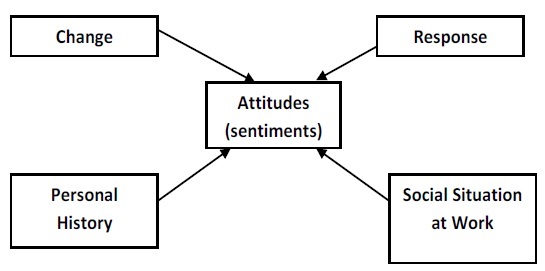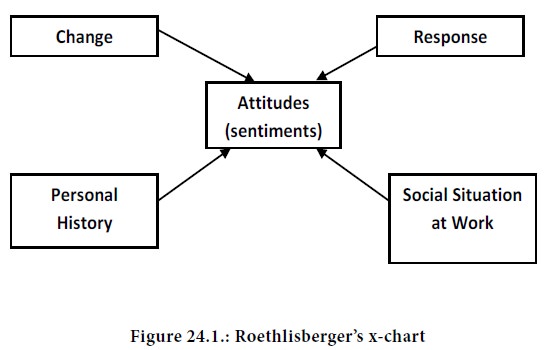Home | ARTS | Management Concepts & Organisational Behaviour
|
Sources of Resistance to Change - Organisational Change
Management Concepts & Organisational Behaviour - Organisational Change
Sources of Resistance to Change - Organisational Change
Posted On :

Any change is complicated by the fact that it does not produce a direct adjustment.
Sources of Resistance to
Change
Any change is complicated by the fact that it does not produce a direct adjustment. Instead, it operates through employees attitudes to produce a response that is conditioned by feelings towards change. The following chart known as Roethlisberger’s x-chart explains how attitudes affect the response to change.

Logical: arises from the time and effort needed to adjust to change. It is also due to new job duties to be learnt. These are short run costs to be paid by employee, though in the long term they are benefited by change.
Psychological: may arise due to attitudes and feelings of individuals about change. They fear the uncertainty, mistrust the management and feel insecurity. Therefore prefer status quo.
Sociological: political conditions, opposing union values, narrow outlook, vested interests, and desire to retain existing friendship are some of the reasons for resisting change.
Alternatively, resistance to change can also be studied under individual resistance and organizational resistance.
Individual
resistance: The source of resistance resides
in basic human characteristics,
which are presented hereunder in a summary form:
Habit: To cope with life complexity, human beings rely on habits or programmed responses. Confronted with a change, the tendency to respond in habitual ways is a source of resistance.
Security: persons with high need for security resist change. In technologically intensive society, people perceive threats to the jobs and economic security. Hence, they resist change.
Economic factor: one’s concern that change will lower one’s income is another source of resistance. When pay is tied to performance, people fear that they may lose their income by not being successful in performing their new job, more so when they need to apply new set of skills.
Need for security blanket (Fear of the Unknown): apart from economic and job security, people prefer predictability and structured patterns in their lives. The need for this security blanket also makes them apprehensive about the change that characterizes ambiguity and uncertainty. Therefore, the preference for known for the unknown is obvious.
Selective information processing: people see the world through their perceptions.They see and try to understand and accept information that is palatable to them. They ignore information that challenges the wolld they wish to operate in.
Apprehension about understanding of status and authority: change in technology of work methods “undermining authority and status” is a source of resistance to change.
Resistance is stemming from retooling and retraining: knowing that one has to learn new things is a source of resistance to change as any learning involves unlearning.
Resistance due to non -involvement in the change process: when changes are incorporated with little input from those who are affected by them, resistance to change is expected.
Resistance due to sunk costs: older employees seem to resist change more than younger ones. They have more psychological investment in older traditions. This is otherwise known as ‘sunk cost’ of energy and time.
Organizational Resistance: organizations by their very nature are conservative. They also become blindfolded and resist change. Six sources of organizational resistance to change are explained in what follows:
Structural inertia: organizations have built in mechanisms to produce stability such
as selection process which chooses certain persons, training and socialization
process reinforcing specific role requirements and skills and formalization of
jobs for employees to follow. When change confronts organizations, their
structural inertia acts as a counter force to organizational stability.
Limited focus of change: limited changes in sub-systems of the organization are likely to be opposed.
Group inertia: here group norms act as constraints for change. Threat to Expertise: organizational changes may be threat to the expertise of specialized groups. For example, decentralized end user computer was a threat to the specialized skills held by the centralized information systems departments.
Threat to established power relationship: any redistribution of authority for decision-making can be threat to established power relationships. For example, participative management is a kind of change seen as a threat to the authority of middle level managers.
Threat to established resource allocation: change is seen as a threat by those groups controlling sizeable resources of the organization.
Consequences of Resistance to change: consequences are both positive and negative
Positive consequences
-- Resistance may force management to reexamine change proposals so that they are appropriate.
-- Resistance also pinpoints specific problem areas so that management can take corrective action before problems become serious.
-- It also encourages management to communicate change which in the long run ensures acceptance of change.
Negative consequences
Organizations failing to overcome resistance to change have to pay a price. Change of greater magnitude introduced without gaining employee acceptance may lead to overt consequence such as employee unrest leading to strike, gherao, sabotage, etc. Implicit reactions to change may lead to alienation from the job i.e., tardiness, absenteeism and turnover.
Any change is complicated by the fact that it does not produce a direct adjustment. Instead, it operates through employees attitudes to produce a response that is conditioned by feelings towards change. The following chart known as Roethlisberger’s x-chart explains how attitudes affect the response to change.

From the above chart, it is
obvious that how people feel about change ultimately determines the response to
change. People as individuals interpret change with attitudes in the back
ground. The response is expressed through the group behavior. All changes have
some costs, economic, psychological and social costs. Because of these costs
associated with change, initiatives for change require analysis to determine
their usefulness. Hence, cost benefit analysis of change is required. The goal
of any organization is to maximize the benefits. Organizational members are
affected in different ways by a change. Some may benefit while others suffer
losses. This is the reason why employees tend to resist work change because of
the associated costs. The following are reasons for, and consequences of,
resistance to change.
Three Types of Resistance to Change
They are
Logical, psychological and sociological
Logical: arises from the time and effort needed to adjust to change. It is also due to new job duties to be learnt. These are short run costs to be paid by employee, though in the long term they are benefited by change.
Psychological: may arise due to attitudes and feelings of individuals about change. They fear the uncertainty, mistrust the management and feel insecurity. Therefore prefer status quo.
Sociological: political conditions, opposing union values, narrow outlook, vested interests, and desire to retain existing friendship are some of the reasons for resisting change.
Alternatively, resistance to change can also be studied under individual resistance and organizational resistance.
Habit: To cope with life complexity, human beings rely on habits or programmed responses. Confronted with a change, the tendency to respond in habitual ways is a source of resistance.
Security: persons with high need for security resist change. In technologically intensive society, people perceive threats to the jobs and economic security. Hence, they resist change.
Economic factor: one’s concern that change will lower one’s income is another source of resistance. When pay is tied to performance, people fear that they may lose their income by not being successful in performing their new job, more so when they need to apply new set of skills.
Need for security blanket (Fear of the Unknown): apart from economic and job security, people prefer predictability and structured patterns in their lives. The need for this security blanket also makes them apprehensive about the change that characterizes ambiguity and uncertainty. Therefore, the preference for known for the unknown is obvious.
Selective information processing: people see the world through their perceptions.They see and try to understand and accept information that is palatable to them. They ignore information that challenges the wolld they wish to operate in.
Apprehension about understanding of status and authority: change in technology of work methods “undermining authority and status” is a source of resistance to change.
Resistance is stemming from retooling and retraining: knowing that one has to learn new things is a source of resistance to change as any learning involves unlearning.
Resistance due to non -involvement in the change process: when changes are incorporated with little input from those who are affected by them, resistance to change is expected.
Resistance due to sunk costs: older employees seem to resist change more than younger ones. They have more psychological investment in older traditions. This is otherwise known as ‘sunk cost’ of energy and time.
Organizational Resistance: organizations by their very nature are conservative. They also become blindfolded and resist change. Six sources of organizational resistance to change are explained in what follows:
Limited focus of change: limited changes in sub-systems of the organization are likely to be opposed.
Group inertia: here group norms act as constraints for change. Threat to Expertise: organizational changes may be threat to the expertise of specialized groups. For example, decentralized end user computer was a threat to the specialized skills held by the centralized information systems departments.
Threat to established power relationship: any redistribution of authority for decision-making can be threat to established power relationships. For example, participative management is a kind of change seen as a threat to the authority of middle level managers.
Threat to established resource allocation: change is seen as a threat by those groups controlling sizeable resources of the organization.
Consequences of Resistance to change: consequences are both positive and negative
Positive consequences
-- Resistance may force management to reexamine change proposals so that they are appropriate.
-- Resistance also pinpoints specific problem areas so that management can take corrective action before problems become serious.
-- It also encourages management to communicate change which in the long run ensures acceptance of change.
Negative consequences
Organizations failing to overcome resistance to change have to pay a price. Change of greater magnitude introduced without gaining employee acceptance may lead to overt consequence such as employee unrest leading to strike, gherao, sabotage, etc. Implicit reactions to change may lead to alienation from the job i.e., tardiness, absenteeism and turnover.
Tags : Management Concepts & Organisational Behaviour - Organisational Change
Last 30 days 3616 views













